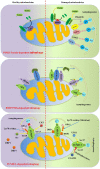Phytochemicals: Targeting Mitophagy to Treat Metabolic Disorders
- PMID: 34414181
- PMCID: PMC8369426
- DOI: 10.3389/fcell.2021.686820
Phytochemicals: Targeting Mitophagy to Treat Metabolic Disorders
Abstract
Metabolic disorders include metabolic syndrome, obesity, type 2 diabetes mellitus, non-alcoholic fatty liver disease and cardiovascular diseases. Due to unhealthy lifestyles such as high-calorie diet, sedentary and physical inactivity, the prevalence of metabolic disorders poses a huge challenge to global human health, which is the leading cause of global human death. Mitochondrion is the major site of adenosine triphosphate synthesis, fatty acid β-oxidation and ROS production. Accumulating evidence suggests that mitochondrial dysfunction-related oxidative stress and inflammation is involved in the development of metabolic disorders. Mitophagy, a catabolic process, selectively degrades damaged or superfluous mitochondria to reverse mitochondrial dysfunction and preserve mitochondrial function. It is considered to be one of the major mechanisms responsible for mitochondrial quality control. Growing evidence shows that mitophagy can prevent and treat metabolic disorders through suppressing mitochondrial dysfunction-induced oxidative stress and inflammation. In the past decade, in order to expand the range of pharmaceutical options, more and more phytochemicals have been proven to have therapeutic effects on metabolic disorders. Many of these phytochemicals have been proved to activate mitophagy to ameliorate metabolic disorders. Given the ongoing epidemic of metabolic disorders, it is of great significance to explore the contribution and underlying mechanisms of mitophagy in metabolic disorders, and to understand the effects and molecular mechanisms of phytochemicals on the treatment of metabolic disorders. Here, we investigate the mechanism of mitochondrial dysfunction in metabolic disorders and discuss the potential of targeting mitophagy with phytochemicals for the treatment of metabolic disorders, with a view to providing a direction for finding phytochemicals that target mitophagy to prevent or treat metabolic disorders.
Keywords: inflammatory response; metabolic disorders; mitochondrial dysfunction; mitophagy; oxidative stress; phytochemicals.
Copyright © 2021 Su, Guo, Huang, Feng, Tang, Zheng and Zhu.
Conflict of interest statement
The authors declare that the research was conducted in the absence of any commercial or financial relationships that could be construed as a potential conflict of interest.
Figures




References
-
- Ahmed S., Khan H., Mirzaei H. (2019). Mechanics insights of curcumin in myocardial ischemia: Where are we standing? Eur. J. Med. Chem. 183:111658. - PubMed
Publication types
LinkOut - more resources
Full Text Sources
Miscellaneous

